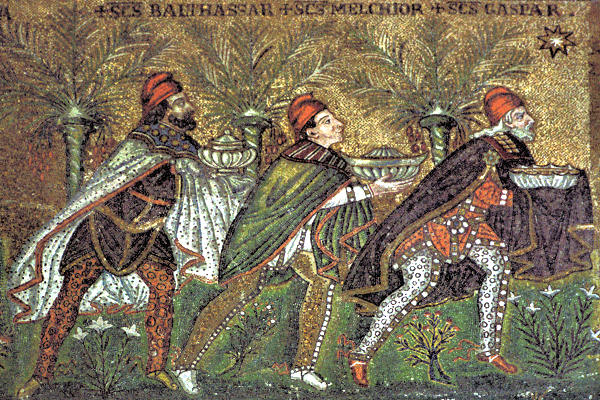 (Feast of the Epiphany ~ January 6 )
(Feast of the Epiphany ~ January 6 )
…behold, there came wise men from the east to Jerusalem, saying “where is he that is born King of the Jews? For we have seen his star in the east, and are come to worship him.” [Matthew 2:1-2]
When St. Matthew provided the church with the story of the Wise Men, he gave us a wonderful testimony to the fact that Christ is the Savior of the Gentiles as well as the Jews. Matthew was probably writing from Antioch just after the fall of Jerusalem in 70AD, where Jews escaping the accusations against them in Jerusalem were worshiping with Gentile Christians. All the details of the events surrounding the visit of the Magi have been studied, pondered, meditated upon, written about, speculated about throughout the centuries. Liturgically, this story was at first part of the Nativity celebration (and has remained so in the Eastern rite), but gradually in the West, the Feast of the Epiphany provided an opportunity to emphasize the events surrounding the visit of the Magi.
Although the New Testament account does not give the number of the Wise Men, Origen first designated their number as three. Their names first appeared in the 6th century in Excerpt Latina Barbari and Bede also names them in his Collectianea et Flores in the 8th century. Early visual representations of the Magi include a wall painting in the Catacomb of Priscilla in Rome dating from the 2nd or 3rd century; a 4th -century sarcophagus carving now in the Vatican Museum, and mosaic representations in the church of Sant Apollinare Nuovo in Ravenna.
The story of the Magi has provided scientists with questions concerning the star and the dating of the birth of Christ. Babylonian astronomy was so refined by the time of our Lord’s birth that almanacs were produced in advance with monthly calculations of the positions of the stars, dates of eclipses, solstices, equinoxes, etc. Since astronomy and astrology were not separate “fields” in this day, astronomers also took star positions as omens of events to happen and made predictions based on what could be seen in the heavens. Almanacs for the year 7BC, discovered in archeological excavations in Babylon, reveal a planetary phenomenon (“an 11-month conjunction of Jupiter and Saturn in Pisces”, which happens only once every 800 years, according to Simo Parpola in Biblical Review) which could have led them on a journey to seek a new-born king.
The Fathers of the church, in viewing the Old Testament as prophecy for the events described in the New Testament, see Pslam 72 as speaking of the Magi: “the kings of Tarshish and of the isles shall give presents; the kings of Arabia and Saba shall bring gifts”, and this Psalm is quoted in the minor propers for the Feast of Epiphany. Isaiah 60, “…all they from Sheba shall come; they shall bring gold and incense…” is the Lesson for Epiphany. St. Irenaeus of Lyons, as many others, spoke of the gifts of the Wise Men as acknowledgment of Jesus as divine (frankincense for worship of the divine); as our King (gold suitable for royalty); who came to die for us (myrrh to anoint Him for burial). St. Leo the Great wrote of the Wise Men recognizing Christ’s human and divine natures and as being both a heavenly king and a king in the line of King David.
According to tradition, the bodies of the Magi were discovered by St. Helena and taken to Constantinople. They were then presented to St. Eustorgius, bishop of Milan. (When the church in that city dedicated to him was renovated in 1764, evidence of an earlier burial site was discovered containing coins from the reign of Emperor Constans, the son of St. Constantine.) The 4th century sarcophagus is still on display in this church. In the 12th century, this church was sacked by Frederick Barbarosa and the relics of the Magi were taken to the city of Cologne where they were enshrined. In 1794, before the destruction which occurred in the French Revolution, the relics were removed and taken as far as Prague before being safely returned to Cologne.
The story of the Wise Men has stirred the imaginations of many people through the centuries. Marco Polo was eager to report having seen their tomb in Persia in the 14th century. John of Hildesheim’s Story of the three Kings (a delightful mixture of folk-tale, history, and religious story) which continues the story of the Magi after their return home, was written in Latin between 1364 and 1375. It was such a “best-seller” that it was translated into German by 1389 and into English around 1400. The Serbs have a wonderful story of Artibanes, a would-be fourth Wise Man – a story which has been adapted and made into a film in modern times.
Each Epiphany, as we have our homes blessed and invoke the prayers of Saints Caspar, Melchior and Balthazar, may we, like them, fall down and worship him – Christ, our King and Savior.